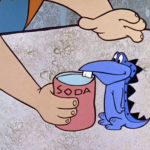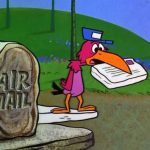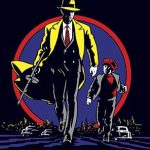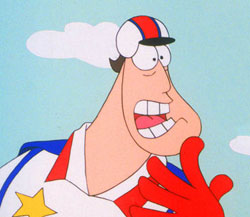 Live Action Flintstones Creatures. Bruce Cohen, the producer of the live action feature film The Flintstones (1994) said in a publicity interview for the film in 1994, “In most cases (the animals used as devices) were from the (animated) show. We worked with Hanna-Barbera on the project and they had a great visual library of all the original creatures on the series. So we had a bible of all the sketches. Our creative people got so in-synch that even things we thought we had invented we found in the original animated show later.”
Live Action Flintstones Creatures. Bruce Cohen, the producer of the live action feature film The Flintstones (1994) said in a publicity interview for the film in 1994, “In most cases (the animals used as devices) were from the (animated) show. We worked with Hanna-Barbera on the project and they had a great visual library of all the original creatures on the series. So we had a bible of all the sketches. Our creative people got so in-synch that even things we thought we had invented we found in the original animated show later.”
 Bruce Sandell, production designer said, “We sat down and watched 160 or so episodes in my office. We were trying to do our homework. Flintstones fans everywhere demand that we see the beasts. The Dictabird, the talking shaver, the bird whistle at the end of a workday. It’s a far cry from drawing it in a cartoon.
Bruce Sandell, production designer said, “We sat down and watched 160 or so episodes in my office. We were trying to do our homework. Flintstones fans everywhere demand that we see the beasts. The Dictabird, the talking shaver, the bird whistle at the end of a workday. It’s a far cry from drawing it in a cartoon.
Coming up with a 3-D interactive creation, that was a chllenge. We have a little pig that’s the garbage disposal. There were four people hidden underneath the floor with their hands up inside the creature. There were others with cameras, moving the lips and eyeballs with remote control. They were all jammed inside the set.”
Set decorator Rosemary Brandenburg said, “At first, we started thinking of them as props. Then after working with the Hensons (Henson Creature Shop), we started thinking of them as having temperaments. They became real beings.”

The Birth of Robotech. Carl Macek was a veteran film and video producer who was running a gallery in Los Angeles selling animation cels. He acquired a selection of Japanese anime at the request of one of his customers in the 1980s and saw the work’s uniqueness so struck a deal with Harmony Gold to produce a syndicated series re-utlizing existing Japanese animation.
The 1985 series Robotech never existed in Japan. Macek wove togther three entirely unconnected series — Macross, Southern Cross and Genesis Clibmer Mospeada – by rescripting and redubbming them into one epic to get enough episodes for syndication.
“The three series had not been geared to be put together,” Macek told the Village Voice reporter Jeff Yang in 1992. “The reason was that I had to find a minimum of 65 episodes of programming. By going through these series I was able to find 64 episodes; then I made an episode from scratch by piecing together material to come up with episode 65. And that was Robotech. If the (true Japanese anime) fans embrace it, great. If they don’t, I’m not going to cry because I’m not making it for them.”
 Animated Series That Never Were. In TV Times, February 24-March 2, 1991, Disney TV Animation executive Gary Krisel said that Disney was looking at developing Dick Tracy and The Rocketeer into animated Saturday morning series. Krisel said that while both would be extremely viable, there were no immediate plans and definitely none for the next Fall.
Animated Series That Never Were. In TV Times, February 24-March 2, 1991, Disney TV Animation executive Gary Krisel said that Disney was looking at developing Dick Tracy and The Rocketeer into animated Saturday morning series. Krisel said that while both would be extremely viable, there were no immediate plans and definitely none for the next Fall.
Krisel said Disney was being careful about announcing when a series might appear because a number of animated series had been plagued by the inability to meet production deadlines because of increased demand for the services of animation facilities in the Far East. It was noted that Disney and Warner Brothers would be producing more that 500 half hours of animation over the next three years.
Aladdin Research. In the Los Angeles Times for December 11, 1992, writer Betty Goodwin pointed out the different research that was done for Disney’s animated feature film Aladdin (1992): “Persian miniatures were studied at the Metropolitan Museum of Art in New York and the Los Angeles County Museum of Art.
LACMA’s catalogue from the 1989 show ‘Timur and the Princely Vision: Persian Art and Culture in the 15th Century’ was also consulted. Other sources included rapper Hammer’s videos (for the movement of Aladdin’s low-crotch baggy pants) and the 1940s movie ‘The Thief of Baghdad’ for Hollywood-style takes on the period.”
 You Idiot! Vanessa Coffey, Nickelodeon vice president of animation told USA Today in 1992 that she was being bombarded by people wanting to do the voice of Ren on The Ren and Stimpy show once they found out that John Kricfalusi who did the voice had been let go from the series.
You Idiot! Vanessa Coffey, Nickelodeon vice president of animation told USA Today in 1992 that she was being bombarded by people wanting to do the voice of Ren on The Ren and Stimpy show once they found out that John Kricfalusi who did the voice had been let go from the series.
Coffey said, “People call me all day and say ‘You idiot! You bloated sack of protoplasm!’ They can save their quarters. We’re going through talent agents.” Billy West ended up doing the voice along with Stimpy after Kricfalusi very publicly said, “No, I’m not doing the voice. Why would I sell out?”
 Super Dave’s Fuji. Super Dave Osborne was a ficitional stuntman character created and performed by comedian Bob Einstein (the brother of Albert Brooks) whose stunts frequently go terribly wrong despite the assistance of his friend and sidekick Fuji Hakayito. The duo appeared on many television shows (including their own series), commercials and even a feature film. However, when a Saturday morning cartoon series entitled Super Dave: Daredevil for Hire produced by DIC debuted in September 1992 there was trouble.
Super Dave’s Fuji. Super Dave Osborne was a ficitional stuntman character created and performed by comedian Bob Einstein (the brother of Albert Brooks) whose stunts frequently go terribly wrong despite the assistance of his friend and sidekick Fuji Hakayito. The duo appeared on many television shows (including their own series), commercials and even a feature film. However, when a Saturday morning cartoon series entitled Super Dave: Daredevil for Hire produced by DIC debuted in September 1992 there was trouble.
In the Los Angeles Times for November 10, 1992, it was reported that child psychologist Kenyon S. Chan, chairman of Asian American studies at Cal State Northridge, had forcefully complained to the Fox Children’s Network Advisory Board about the design of the character of Super Dave’s assistant, Fuji. He claimed that the short statture, protruding lips, “slit eyes” behind enormous glasses and heavy Asian accent were demeaning and a throwback to the “worst stereotypes I have ever seen in the media. I don’t want Fox to eliminate the Fuji character from the series. I just wanted them to humazie the character. Fuji can be funny without being insulting.”
 Magaret Loesch, president of Fox Children’s Network, responded that they would soon start shooting new live-action openings equences which would feature Asian-Canadian comedian Art Irizawa (the voice of Fuji). “The purpose of these new live sequences is to show the audience that Fuji is not a buffoon but is based on a real actor who happens to speak this way,” she stated. “Children will see how he really looks and that the drawing is an exaggeration of his personality, not a stereotypical portrayal. We just wanted to solve a problem before it became a real problem.”
Magaret Loesch, president of Fox Children’s Network, responded that they would soon start shooting new live-action openings equences which would feature Asian-Canadian comedian Art Irizawa (the voice of Fuji). “The purpose of these new live sequences is to show the audience that Fuji is not a buffoon but is based on a real actor who happens to speak this way,” she stated. “Children will see how he really looks and that the drawing is an exaggeration of his personality, not a stereotypical portrayal. We just wanted to solve a problem before it became a real problem.”
Stephanie Graziano, the network’s director of animation said that she, Irizawa and Bob Einstein (who portrays Super Dave) would be meeting shortly to discuss voice and drawing revisions for the second series (that was never produced). The series was cancelled after its first season, but a half hour special based on the series titled The Super Dave Superbowl of Knowledge aired on January 29, 1994. Irizawa subsequently re-recorded his dialogue for all of the show’s episodes.


 Jim Korkis is an internationally respected animation historian who in recent years has devoted his attention to the many worlds of Disney. He was a columnist for a variety of animation magazines. With his former writing partner, John Cawley, he authored several animation related books including The Encyclopedia of Cartoon Superstars, How to Create Animation, Cartoon Confidential and Get Animated’s Animation Art Buyer’s Guide. He taught animation classes at the Disney Institute in Florida as well as instructing classes on acting and animation history for Disney Feature Animation: Florida.
Jim Korkis is an internationally respected animation historian who in recent years has devoted his attention to the many worlds of Disney. He was a columnist for a variety of animation magazines. With his former writing partner, John Cawley, he authored several animation related books including The Encyclopedia of Cartoon Superstars, How to Create Animation, Cartoon Confidential and Get Animated’s Animation Art Buyer’s Guide. He taught animation classes at the Disney Institute in Florida as well as instructing classes on acting and animation history for Disney Feature Animation: Florida.




















































I was wondering why Super Dave was abruptly cancelled when Politically Correctiveness rears it’s head.
The same thing happened to Santo Bugito (1995) – a animated series by the creators of Rugrats & AAAAAAH!!! Real Monsters (Klasky-Csupo Animation) – about a community of insects living in a Borderlands town between Texas and Mexico almost like Mr Bug Goes to Town with a Tex Mex twist. Several Hispanic groups condemned the series because of several of the characters in question but a “Border Blaster” radio station from Rosario Baja California Norte Mexico XPRS am urged listeners who write letters to CBS Television to save Santo Bugito from being canceled by to no avail, CBS canceled the series after one season in 1996.
And of course the revival of the Dick Tracy Show in 1990 to promote the Dick Tracy movie that was released in the same year (since it was the only full length television program based on Dick Tracy unlike the more truer segment that appeared on Archie’s TV Funnies) and were met by protesters from Asian and Hispanic groups (many who weren’t born when The Dick Tracy Show originally came out in 1961) because of the two characters Joe Jitsu (who was loosely based on Asian crime fighters Charlie Chan and Mr. Moto) & Go Go Gomez. Eventually The Revival of The Dick Tracy Show was still broadcast on Los Angeles TV station KCAL 9 (who at the time was owned by Disney) until July 4th 1990. To quote Henry G. Saperstien then the chairman of UPA “It’s just a cartoon,for goodness sake!”
Obviously Saperstien’s words still tend to fall of deaf ears to this very day!
My favorite animal gag from a later “Flintstones” episode (Circa 1964/65) involved a basketball game, in which ‘Hoppy’ the hopperoo served as the basket, and a skunk with a piece of chalk kept the score. “If you’ll excuse the expression,” said the striped scorekeeper (voiced by Don Messick), “looks like the home team got skunked!”
Also censored (all the way to removing the “offending” original soundtracks from the cartoons) were the MR. MAGOO television cartoons that featured Charlie, Mr. Magoo’s housekeeper who always seemed to get tangled up in Magoo’s hazardous situations. When it came to releasing the entire television series on DVD, original soundtracks conveniently could not be found. If there is more to this story, please feel free to correct me.
The post on “Robotech” reminds me. . .
In he middle 1980s, I would take a bus from my home town of Fillmore to Ventura, and back, to do shopping. Aside from the driver, I was often the only adult on the bus. The rest of the passengers were children who were being sent off to a Catholic school in Ventura.
Soon after the show premiered, I remember overhearing some of the kids talking about “Robotech”
Nobody liked it at all.
One kid was complaining about the “soap-opera plotting” of this space opera.
I’m sure that Macek and company were disappointed when stations programmed “Robotech” in kid-show time slots, and promoted it as just another kid show, in an era of “Inspector Gadget” and “G. I. Joe”.
Likely as not, Macek and company would have preferred stations putting the show into seven or seven-thirty slots in the evening, hoping for an older demographic.
But the “Cartoons Are For Kids Only” attitude ruled the day at that time.
It was a shame indeed, but it was that hard to get anyone who wasn’t 7-11 to watch cartoons seriously yet.
— In TV Times, February 24-March 2, 1991, Disney TV Animation executive Gary Krisel said that Disney was looking at developing Dick Tracy and The Rocketeer into animated Saturday morning series. Krisel said that while both would be extremely viable, there were no immediate plans and definitely none for the next Fall. —
I wondered that now since Bullethead Baloo from TaleSpin was basically a parody of the Rocketeer movie.